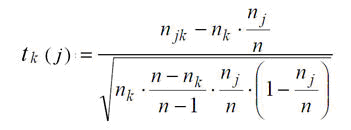|
www.tlab.it
Test Value
This is a statistical measure which T-LAB uses to
characterise two kinds of relationships:
a) those concerning lexical units with variable
categories, the occurrences of which are summarized in contingency
tables;
b) those concerning any row and column of a contingency table with
the factors detected by a correspondence
analysis of such a table.
Depending on the relationships analysed, the formulas of
the test value, taken from one of the bibliography volumes (Lebart
L. Morineau A. Piron M. , 1995, pp. 181-184), are the
following:
a)

where 'njk' indicates the occurrences within a cell,
while 'nj' and 'nk' correspond respectively to the marginal total
of a row and of a column.
b)

where "nj" and " j" indicate respectively the occurrences
of the j-th object and its coordinate on the -th factorial
axis.
The test value has two significant properties: a
threshold value (1.96), corresponding to the statistical
significance most commonly used (p. 0.05), and a sign (-/+).
This means that, after sorting the values in an ascending
or descending order, it is possible to quickly single out the
relevance of each analysed item.
T-LAB allows a
Test Value table consultation in an interactive way.
|